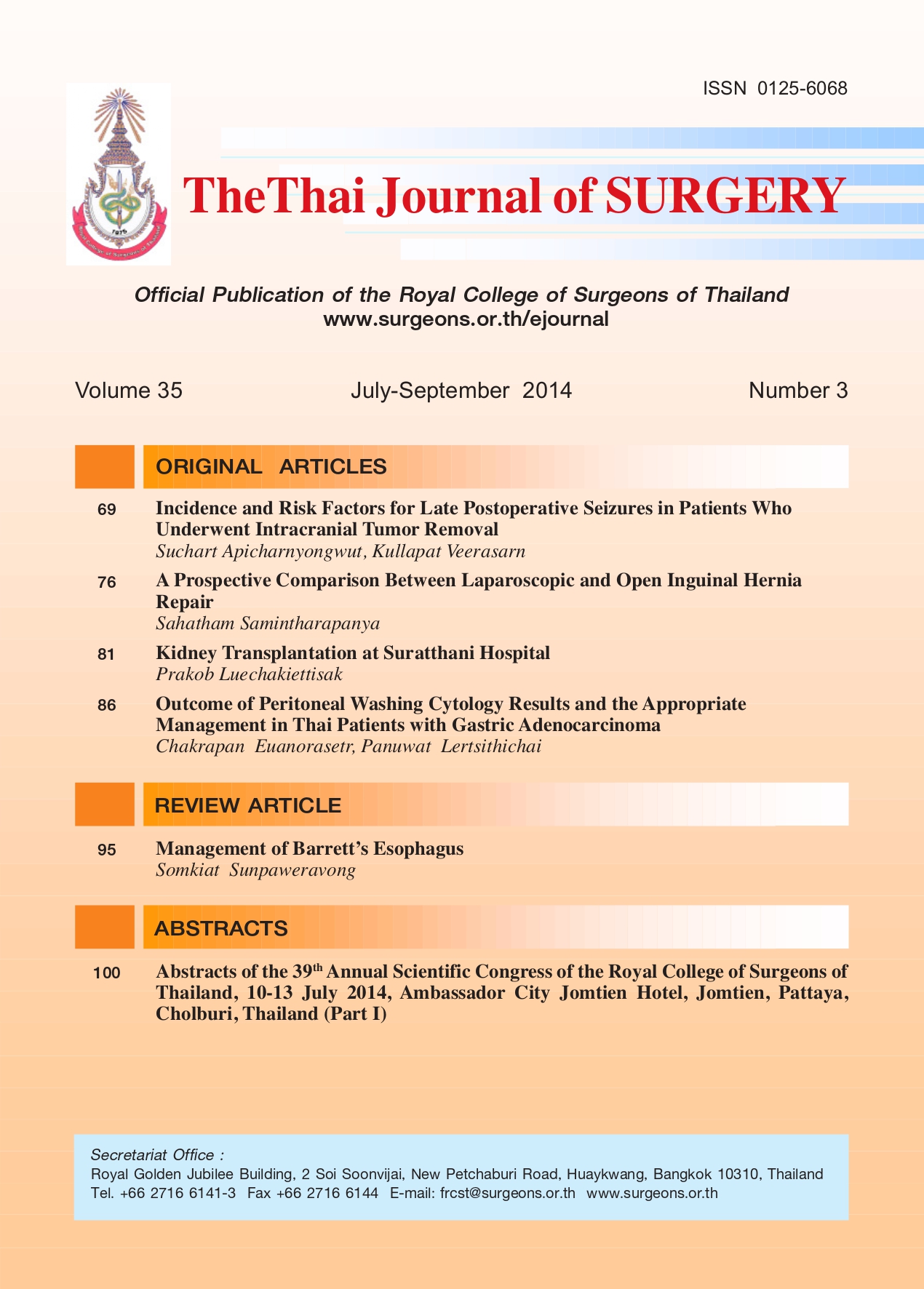Kidney Transplantation at Suratthani Hospital
Keywords:
Kidney transplantation, live donor, graft survivalAbstract
Background and objective: Kidney transplantation is associated with improved quality of life and better survivalamong patients with end-stage renal disease. The aim of this study is to assess the experience of Suratthani Hospital’s
kidney transplant program which began in 2008.
Materials and Methods: The records of 8 pairs of donors and recipients who received kidney transplants over
a 5-year period were collected and analyzed. All received kidneys from live donors.
Results: The mean donor age was 39.3 ± 8.8 years (range, 28 to 53 years) and the mean recipient age was 32.0
± 9.3 years (range, 21 to 48 years). There were 4 male donors (50%) and 4 female donors (50%), while the 8 recipients
included 6 males (75%) and 2 females (25%). The donors were siblings of the recipients in 3 cases (37.5%), parents in
3 cases (37.5%), a relative in 1 case (12.5%) and a spouse in 1 case (12.5%). No acute graft rejection was seen in all cases.
One case had delayed graft function due to CMV infection. Graft survival was 100%. One recipient died three years after
transplantation from unknown cause, but the kidneys were working well for the other seven cases. Six recipients
developed post transplant infections, including urinary tract infection, varicella, herpes zoster, tuberculosis and CMV
infection.
Conclusion: Even though the experience with kidney transplantation in Suratthani is limited, the reported results
are encouraging and offer a promising option for people with kidney disease on dialysis who live in the upper southern
Thailand.
References
26,304 herniorrhaphies in Denmark: a prospective nationwide
study. Lancet 2001;358:1124.
2. Primatesta P, Goldacre MJ. Inguinal hernia repair: incidence
of elective and emergency surgery, readmission and mortality.
Int J Epidemiol 1996; 25:835-9.
3. Butters M, Redecke J, Joninger J. Long-term results of a
randomized clinical trial of Shouldice, Lichtenstein and
transabdominal preperitoneal hernia repairs. Br J Surg 2007;
94:562-5.
4. Nordin P, Bartelmess P, Jansson C, Svensson C, Edlund G.
Randomized trial of Lichtenstein versus Shouldice hernia repair
in general surgical practice. Br J Surg 2002;89:45-9.
5. Van Veen RN, Wijsmuller AR, Vrijland WW, Hop Wc, Lange JF,
Jeekel J. Long-term follow-up of a randomized clinical trial of
non-mesh versus mesh repair of primary inguinal hernia. Br J
Surg. 2007; 94:506-10.
6. Bittner R, Sauerland S, Schmedt CG. Comparison of
endoscopic techniques vsShouldice and other open nonmesh
techniques for inguinal hernia repair: a meta-analysis of
randomized controlled trials. Surg Endosc 2005;19:605-15.
7. McCormack K, Scott NW, Go PM, Ross S, Grant AM; EU Hernia
TrialistsCollaboration . Laparoscopic techniques versus open
techniques for inguinal hernia repair. Cochrane Database
Syst Rev 2003;(1): 001785
8. Scott NW, McCormack K, Graham P, Go PM, Ross SJ, Grant
AM. Open mesh versus non-mesh for repair of femoral and
inguinal hernia. Cochrane Database Syst Rev 2002;(4): 002197
9. Bergman S, Feldman LS: inguinal hernia repair in: Souba W.,
Fink MP Jurkovich GJ, editor. ACS surgery principle and practice
6th edition, Philadelphia: Lippincott Raven; 2009.
10. Bringman S, Ramel S, Heikkinen TJ, England T, Westman B and
Ardenberg B: Tension-free inguinal hernia repair: TEP versus
mesh-plug versus Lichtenstein: a prospective randomized
controlled trial. Ann Surg 2003;237:142-7.
11. Collaboration EH.Laparoscopic compared with open methods
of groin hernia repair:Systematic review of randomized
controlled trials. Br J Surg 2000;87:860-7.
12. Grant AM:EH Hernia Trialist Collaboration. Laparoscopic versus
open groin hernia repair: Meta-analysis of randomized trials
based on individual patient data. Hernia 2002;6:2-10.
13. Memon Ma, Cooper NJ, Memon B, et al. Meta-analysis of
randomized trials comparing open and laparoscopic inguinal
hernia repair. Br J Surg 2003;90:1479.
14. Brunicardi F, Anderson D, Sherman V, Macho JR. Inguinal
Hernias. In: Brunieard F, et al. editors. Schwart’z Principle of
Surgery. 9th ed. New York: McGraw - Hill; 2010. p. 1305-42.
15. Amid PK, Shulman AG, Lichtenstein IL. Open çtension-freeé
repair of inguinal hernias: The Lichtenstein technique. Eur J
Surg 1996;162:447-53.
16. McKernan JB, Laws HI. Laparoscopic repair of inguinal hernias
using a totally extraperitoneal prosthetic approach. Surg
Endosc 1993;7:26.
17. Johnson EM, Anderson JK, Jacobs C, et al. Long-term
follow-up of living kidney donors: quality of life after
donation. Transplantation 1999;67:717-21.
18. Fehrman-Ekholm I, Nordien G, Lennerling A. et al. Incidence
of end-stage renal disease among live kidney donors.
Transplantation 2006;82:1646-8.
Downloads
Published
How to Cite
Issue
Section
License
Articles must be contributed solely to The Thai Journal of Surgery and when published become the property of the Royal College of Surgeons of Thailand. The Royal College of Surgeons of Thailand reserves copyright on all published materials and such materials may not be reproduced in any form without the written permission.



